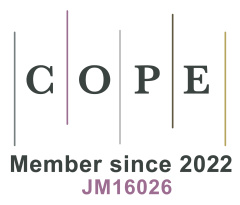Diagnosis and correlation analysis of lung cancer based on multi-parameter regression of respiratory volatile organic compounds
Abstract
Lung cancer is a prevalent and life-threatening disease worldwide. The primary diagnostic approach for lung cancer is the utilization of low-dose spiral CT scans. However, repeated scans can expose patients to harmful radiation. Consequently, there is growing interest in exploring alternative methods such as the analysis of exhaled volatile organic compounds (VOCs) for lung cancer detection. In this study, we employed a gas chromatography-mass spectrometry analyzer to identify and quantify a total of 108 VOCs of lung cancer patients. Our objective is to investigate the correlation between VOCs in exhaled breath and lung cancer. Through the application of orthogonal partial least squares-discriminant analysis and correlation analysis, we identified several VOCs, including acetone, ethanol, isopropanol, and ethyl acetate, which exhibited a strong association with lung cancer. Unlike the use of a single marker, our study employed a multi-parameter regression method, resulting in superior accuracy. A diagnostic model based on the neural network algorithm was established, demonstrating an accuracy of 93.5% after screening, surpassing the accuracy before screening at 81%. Furthermore, we optimize the model by incorporating the gender factor, leading to an accuracy exceeding 96%. Numerous studies have demonstrated that the analysis of VOCs in exhaled breath holds significant potential for effectively distinguishing lung cancer patients from healthy individuals. These findings emphasize the potential of respiratory analysis as a novel diagnostic tool for early detection of lung cancer.
References
1. Li Y, Wu X, Yang P, et al. Machine Learning for Lung Cancer Diagnosis, Treatment, and Prognosis. Genomics, Proteomics & Bioinformatics. 2022; 20(5): 850-866. doi: 10.1016/j.gpb.2022.11.003
2. Svoboda E. Research round-up: Allergies. Nature. 2020; 588(7836): S2-S3. doi: 10.1038/d41586-020-02776-6
3. Brunetti A, Altini N, Buongiorno D, et al. A Machine Learning and Radiomics Approach in Lung Cancer for Predicting Histological Subtype. Applied Sciences. 2022; 12(12): 5829. doi: 10.3390/app12125829
4. Tan WL, Jain A, Takano A, et al. Novel therapeutic targets on the horizon for lung cancer. Lancet Oncol. 2016; 17(8): e347-e362. doi: 10.1016/S1470-2045(16)30123-1
5. Wang Y, Chen E. Interventional bronchoscopic treatment of lung cancer. Laparoscopic, Endoscopic and Robotic Surgery. 2022; 5(2): 52-56. doi: 10.1016/j.lers.2021.09.005
6. Dhaware BU, Pise AC. Lung cancer detection using Bayasein classifier and FCM segmentation. 2016 International Conference on Automatic Control and Dynamic Optimization Techniques (ICACDOT). Published online September 2016. doi: 10.1109/icacdot.2016.7877572
7. Rahouma KH, Mabrouk SM, Aouf M. Lung Cancer Diagnosis Based on Chan-Vese Active Contour and Polynomial Neural Network. Procedia Computer Science. 2021; 194: 22-31. doi: 10.1016/j.procs.2021.10.056
8. Bevilacqua V, Brunetti A, Guerriero A, et al. A performance comparison between shallow and deeper neural networks supervised classification of tomosynthesis breast lesions images. Cognitive Systems Research. 2019; 53: 3-19. doi: 10.1016/j.cogsys.2018.04.011
9. Song MA, Benowitz NL, Berman M, et al. Cigarette Filter Ventilation and its Relationship to Increasing Rates of Lung Adenocarcinoma. JNCI: Journal of the National Cancer Institute. 2017; 109(12). doi: 10.1093/jnci/djx075
10. Aerts HJWL. The Potential of Radiomic-Based Phenotyping in Precision Medicine. JAMA Oncology. 2016; 2(12): 1636. doi: 10.1001/jamaoncol.2016.2631
11. Cao W, Duan Y. Current Status of Methods and Techniques for Breath Analysis. Critical Reviews in Analytical Chemistry. 2007; 37(1): 3-13. doi: 10.1080/10408340600976499
12. Dandıl E. A Computer-Aided Pipeline for Automatic Lung Cancer Classification on Computed Tomography Scans. Journal of Healthcare Engineering. 2018; 2018: 1-12. doi: 10.1155/2018/9409267
13. Kamysek S, Fuchs P, Schwoebel H, et al. Drug detection in breath: effects of pulmonary blood flow and cardiac output on propofol exhalation. Analytical and Bioanalytical Chemistry. 2011; 401(7). doi: 10.1007/s00216-011-5099-8
14. Saalberg Y, Wolff M. VOC breath biomarkers in lung cancer. Clinica Chimica Acta. 2016; 459: 5-9. doi: 10.1016/j.cca.2016.05.013
15. Fuchs P, Loeseken C, Schubert JK, et al. Breath gas aldehydes as biomarkers of lung cancer. International Journal of Cancer. 2010; 126(11): 2663-2670. doi: 10.1002/ijc.24970
16. Phillips M, Cataneo RN, Cummin ARC, et al. Detection of Lung Cancer With Volatile Markers in the Breatha. Chest. 2003; 123(6): 2115-2123. doi: 10.1378/chest.123.6.2115
17. Bousamra M, Schumer E, Li M, et al. Quantitative analysis of exhaled carbonyl compounds distinguishes benign from malignant pulmonary disease. The Journal of Thoracic and Cardiovascular Surgery. 2014; 148(3): 1074-1081. doi: 10.1016/j.jtcvs.2014.06.006
18. Ligor T, Pater Ł, Buszewski B. Application of an artificial neural network model for selection of potential lung cancer biomarkers. Journal of Breath Research. 2015; 9(2): 027106. doi: 10.1088/1752-7155/9/2/027106
19. Shehada N, Cancilla JC, Torrecilla JS, et al. Silicon Nanowire Sensors Enable Diagnosis of Patients via Exhaled Breath. ACS Nano. 2016; 10(7): 7047-7057. doi: 10.1021/acsnano.6b03127
20. Callol-Sanchez L, Munoz-Lucas MA, Gomez-Martin O, et al. Observation of nonanoic acid and aldehydes in exhaled breath of patients with lung cancer. Journal of Breath Research. 2017; 11(2): 026004. doi: 10.1088/1752-7163/aa6485
21. Wang M, Sheng J, Wu Q, et al. Confounding effect of benign pulmonary diseases in selecting volatile organic compounds as markers of lung cancer. Journal of Breath Research. 2018; 12(4): 046013. doi: 10.1088/1752-7163/aad9cc
22. Smith D, Wang T, Sulé‐Suso J, et al. Quantification of acetaldehyde released by lung cancer cells in vitro using selected ion flow tube mass spectrometry. Rapid Communications in Mass Spectrometry. 2003; 17(8): 845-850. doi: 10.1002/rcm.984
23. Amann A, Spanel P, Smith D. Breath Analysis: The Approach Towards Clinical Applications. Mini-Reviews in Medicinal Chemistry. 2007; 7(2): 115-129. doi: 10.2174/138955707779802606
24. Di Natale C, Macagnano A, Martinelli E, et al. Lung cancer identification by the analysis of breath by means of an array of non-selective gas sensors. Biosens Bioelectron. 2023; 18: 1209-1218. doi: 10.1016/S0956-5663(03)00086-1
25. Yu H, Xu L, Cao M, et al. Detection volatile organic compounds in breath as markers of lung cancer using a novel electronic nose. Proceedings of IEEE Sensors 2003 (IEEE Cat No03CH37498). doi: 10.1109/icsens.2003.1279164
26. O’Neill HJ, Gordon SM, O’Neill MH, et al. A computerized classification technique for screening for the presence of breath biomarkers in lung cancer. Clinical Chemistry. 1988; 34(8): 1613-1618. doi: 10.1093/clinchem/34.8.1613
27. Phillips M, Gleeson K, Hughes JMB, et al. Volatile organic compounds in breath as markers of lung cancer: a cross-sectional study. The Lancet. 1999; 353(9168): 1930-1933. doi: 10.1016/S0140-6736(98)07552-7
28. Peng G, Tisch U, Adams O, et al. Diagnosing lung cancer in exhaled breath using gold nanoparticles. Nature Nanotechnology. 2009; 4(10): 669-673. doi: 10.1038/nnano.2009.235
29. Sorocki J, Rydosz A. A Prototype of a Portable Gas Analyzer for Exhaled Acetone Detection. Applied Sciences. 2019; 9(13): 2605. doi: 10.3390/app9132605
30. Xiao C, Ye J, Esteves RM, et al. Using Spearman’s correlation coefficients for exploratory data analysis on big dataset. Concurrency and Computation: Practice and Experience. 2015; 28(14): 3866-3878. doi: 10.1002/cpe.3745
31. Wisanwanichthan T, Thammawichai M. A Double-Layered Hybrid Approach for Network Intrusion Detection System Using Combined Naive Bayes and SVM. IEEE Access. 2021; 9: 138432-138450. doi: 10.1109/access.2021.3118573
32. Poli D, Goldoni M, Corradi M, et al. Determination of aldehydes in exhaled breath of patients with lung cancer by means of on-fiber-derivatisation SPME–GC/MS. Journal of Chromatography B. 2010; 878(27): 2643-2651. doi: 10.1016/j.jchromb.2010.01.022
33. Ligor T, Pater Ł, Buszewski B. Application of an artificial neural network model for selection of potential lung cancer biomarkers. Journal of Breath Research. 2015; 9(2): 027106. doi: 10.1088/1752-7155/9/2/027106
Copyright (c) 2024 Lishan Qin, Yunzhen Wang, Fei Wang, Ziyi Zhu, Raojun Luo, Guojun Lv, Haibin Cui

This work is licensed under a Creative Commons Attribution 4.0 International License.
Copyright on all articles published in this journal is retained by the author(s), while the author(s) grant the publisher as the original publisher to publish the article.
Articles published in this journal are licensed under a Creative Commons Attribution 4.0 International, which means they can be shared, adapted and distributed provided that the original published version is cited.



 Submit a Paper
Submit a Paper
